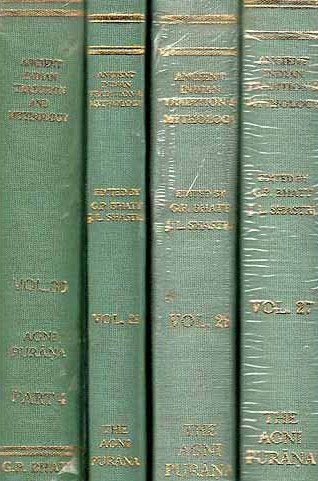The Agni Purana
by N. Gangadharan | 1954 | 360,691 words | ISBN-10: 8120803590 | ISBN-13: 9788120803596
This page describes Description of Phonetics (shiksha) which is chapter 336 of the English translation of the Agni Purana, one of the eighteen major puranas dealing with all topics concerning ancient Indian culture, tradition and sciences. Containing roughly 15,000 Sanskrit metrical verses, subjects contained in the Agni-Purana include cosmology, philosophy, architecture, iconography, economics, diplomacy, pilgrimage guides, ancient geography, gemology, ayurveda, etc.
Chapter 336 - Description of Phonetics (śikṣā)
[Sanskrit text for this chapter is available]
Fire-god said:
1. I shall describe the phonetics [i.e., śikṣā]. The letters are either sixty-three or sixty-four. The vowels are twenty-one. The consonants are twenty-five.
2-3. (The letters) ya and others (the semi-vowels and sibilants) are known to be eight. The twin sounds are four in number—such as the nasal sound, visarga, ka, pa. The letter i is known as (produced) by touching light. It is a protracted sound.
4. (The origin of the letters is described now.) The soul together with the internal organs and those in the abdomen and throat contacts the intellect and joins the mind with a desire to speak.
5. The mind impels the bodily fire, which urges the air to move. The air moving with the chest produces the sound (called) mandra.
6. The Gāyatra metre at the time of morning ablution is recited in that (sound). (The air) moving in the throat gives rise to the (sound) madhyama that which is associated with Triṣṭubh for the midday ablution.
7-8. The air that reaches the head produces the (sound) tārā fit for reciting Jagatī for the third (evening) ablution. The same wind moving upwards strikes against the head, reaches the mouth and produces the letters. These are divided into five (groups) on the basis of the articulation, period (of utterance), place (of articulation), efforts (to utter) and the sense conveyed.
9. Chest, throat, head, root of the tongue, teeth, nose, upper lip and palate are the eight places (of articulation) of the letters.
10. The articulation of the sibilants (ś, ṣ, s and h) are of eight kinds such as innate nature, expansion, śa, ṣa, ra, jihvāmūla (the visarga before k and kh) and upadhmānīya (the visarga before p and ph).
11. The letters u and the like are excellent for combining compositions of metrical nature. The vowels at the end should be known to be of similar nature. Whatever else remain are the explicit sibilants.
12-13. A man incurs sin by pronouncing (letters) from wrong places (of articulation), by inauspicious and defective articulation. Similarly a person incurs merits. A person who employs good sounds, well articulated, according to the treatises and acquired from auspicious sources with a clean mouth shines in the (world of) Brahmā.
14. A person should not use harsh and indistinct letters, nasals, labials excessively with stammering and split tongue.
15. The letters should be uttered in such a way that they are not indistinct and are not mutilated. A person rejoices in the world of Brahmā by employing the letters properly.
16. The sounds are (divided into) three classes (such as) udātta (accentuated), anuāitta (grave accent) and svarita (intermediate). They are distinguished as short, long-and protracted on the basis of the period (of their pronunciation).
17-18. The letters a and ku[1] are from the throat, i and cu are from the palate, u and pu are the labials, the letters ṛ, ṭu, ra and ṣa are the cerebrals, and ḷ, tu, la and sa are the dentals. The sound hvaḥ. is said to be from the root of the tongue. Learned men remember vaḥ. as labio-dental. (The sounds) e and ai are gutturo-palatials. O and au are remembered to belong to the gutturo-labials.
19. The gutturals a, ā, i, e etc. would have half a mātrā value. (The letters) which share the places of articulation are known to be not capable of being combined.
20. The vowels (are known to be) produced not by touch and the letters ya etc. by partial touch. These are known to be consonants not produced by touch. The other consonants are produced by touch. I shall explain the important among them. (The letters) aṃ and aḥ are nasals. (The letters) ha, jha and ṣa are known to have the bellowing sound.
21. The letters ya etc. possess partial sound. Kha, pha etc. are aspirated. The cara is known to have little aspiration. This is said to be long.
Footnotes and references:
[1]:
The letters ku, cu, ṭu, tu, pu stand for the four letters in the respective group.
